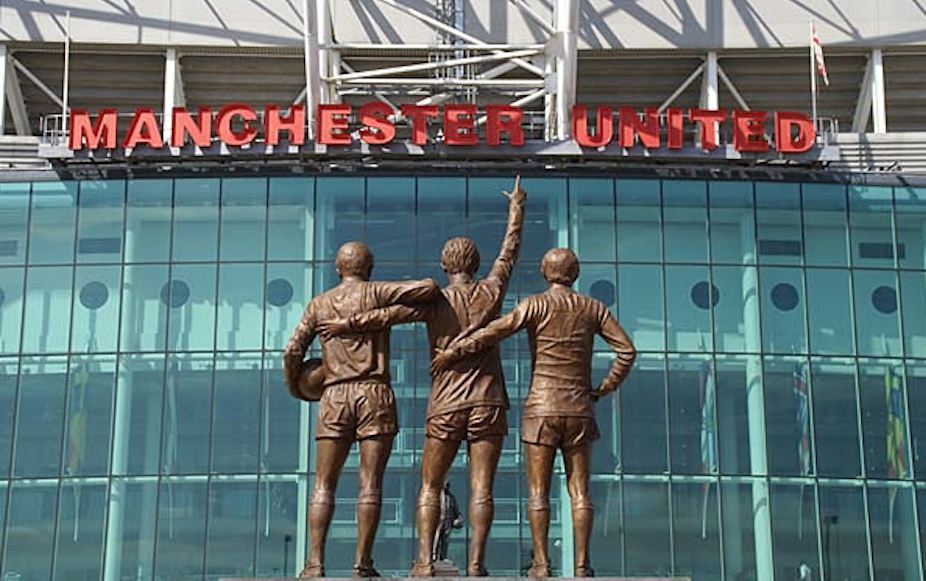DURBAN CLIMATE CHANGE CONFERENCE: With the UN Climate Conference underway in Durban, climate “sceptics” have been particularly active in the media and blogs.
Many climate “sceptics” claim that alternate climate models can explain global warming. These models often rely on apparent correlations between climate and other data. “Sceptics” have claimed climate is strongly correlated with the Southern Oscillation Index, the oscillating position of the sun, and the length of solar cycles.
Anything will do as long as it is not CO₂.
The models are championed by bloggers, sceptics, bloggers, thinktanks and bloggers, but are viewed as deeply flawed by most scientists. To examine the weaknesses of these models, I will introduce a radical new climate “model”.
The Manchester United climate model
Global warming is the most significant scientific and political issue of recent decades. Manchester United is the most significant soccer club of recent decades. Could the two be linked?
I examined this one afternoon, by looking at global temperatures and Manchester United’s FA cup appearances since 1881. I averaged the data over 11 years, to mitigate the impact of the solar cycle.
The results are remarkable. Each Manchester United FA Cup appearance in an 11-year period raised global temperatures by 0.1º Celsius.
A plot of global temperatures and the Manchester United Climate Model reveals that half of global warming is the result of Manchester United.

Is this soccer-climate relationship due to random chance? By randomising Manchester United’s FA Cup appearances, I find the probability of getting such a good relationship by chance is less than 1 in 10,000!
What does this mean for the future? Surely Manchester United’s performance will decline, with star players leaving the club and retiring. Sir Alex Ferguson must also inevitably retire. Thus, global temperatures will surely decline to levels not seen since 1956.
Wrong, wrong, wrong and more wrong
While absurd, the Manchester United Climate Model is no more flawed than many “sceptic” climate “models”.
Firstly, I am not a climate scientist nor am I a soccer expert. Similarly, many “sceptics” have little expertise in climate science. So be warned, if you question my expertise I may respond that you are beholden to the orthodoxy of elitist scientists.
Despite the magic of George Best, David Beckham, Paul Scholes, Ryan Giggs and Wayne Rooney, it is clearly implausible for Manchester United to play a large role in climate change. But hey, climate “sceptics” often suggest implausible drivers of climate change, but this is not obvious to non-scientists.
As with many “sceptic” climate “models”, I have assumed temperature is described by an absurdly simple function, with an FA Cup appearance producing an instant jump in temperature. Similarly, a common “sceptic” tactic is to “prove” greenhouse gases are not causing global warming by assuming an overly simple relationship between carbon dioxide and temperature. Such simple relationships are unrealistic.
“Cherry picking”, or the selective use of data, afflicts the Manchester United Climate Model. I deliberately selected a team that has had great success since the 1950s. I also didn’t tell you that I had looked at AFL and baseball teams before choosing Manchester United.
Cherry picking is also rife within the “sceptic” community. Examples include using data from just a few weather stations or plotting a few years of data so long-term trends are obscured.
I have filtered the data, which can be justified or deceptive. In this case filtering by the length of the solar cycle is a red herring, and the real reason I filtered the data is I didn’t want FA Cup appearances to be equal to just zero or one.
I also ignored established mechanisms for influencing climate. This flaw is present in many “sceptic” climate “models” and produces bogusly strong links between unrelated data.
To demonstrate this, I repeated my analysis for Chelsea, Liverpool and Arsenal. Combining my four soccer club models together, I erroneously explain 180% of global warming. Similarly, combinations of “sceptic” climate models do not work.

How about the statistics? Cherry picking hobbles all subsequent statistics. Also, my statistics are only valid if FA Cup appearances were chance events. This is not the case. If Manchester United appears in an FA Cup, there is an enhanced probability it will be in the following year’s FA Cup.
Given the model’s flaws, its predictions are very dubious. Similarly, many climate “sceptic” predictions are dubious and some have proved to be spectacularly wrong.
Real science
Real climate science is not just comparing plots and looking for correlations. It is based on well-established physics.
Increasing carbon dioxide gradually heats the Earth by blocking infrared radiation. The heating results in increased water vapour in the atmosphere, and this too blocks infrared radiation.
There are many lines of evidence. The ability of these gases to absorb infrared radiation has been measured in the lab, and even on Mythbusters. Scientists can measure the gases’ impact using satellites peering down and telescopes looking up. As heat is trapped in the lower atmosphere, the upper atmosphere cools, and this has been observed.
The warming of the Earth via anthropogenic carbon dioxide emissions has been predicted for decades. While the underlying physics is well understood, predicting the precise temperature rise is difficult. The Earth is complex, and including this complexity requires supercomputer simulations, not hours doodling with spreadsheets.
Many “sceptics” project their ignorance onto science, pretending it is only about comparing plots, drawing straight lines through data and that climate is simple. True climate science is grounded in the laws of physics, verified via observation, recognises complexity and is pursued by professional scientists with years of training and experience. When listening to the debate, keep this in mind and don’t be fooled by the “sceptic” team-mates of the Man U Climate Model.

